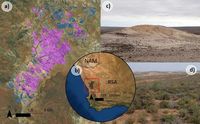Edit: For Immediate Release
Researchers have examined the intricate relationships between spatial parameters, landscape features, and plant diversity on quartz islands in Knersvlakte, South Africa, revealing critical insights about the role of these unique ecosystems.
Quartz islands, often seen as natural edaphic islands, provide specialized habitats for flora and are crucial for biodiversity conservation. In a recent study, scientists evaluated how factors such as island area, habitat diversity, and matrix contrast influence the rich plant life in these arid environments.
The research focused on the Knersvlakte, a semiarid bioregion in South Africa, where quartz islands support a remarkably diverse range of vegetation, including endemics adapted to the harsh conditions. The team surveyed 47 quartz islands, collecting data on plant species and analyzing the spatial characteristics of the islands through extensive satellite imagery.
Preliminary results indicated that both island area and habitat diversity significantly predict plant diversity. Notably, generalist species richness increased with larger island sizes, while quartz specialist richness responded positively to a more complex habitat structure.
Researchers found that the relationships between plant diversity and environmental parameters are not straightforward. The study unveiled that distance-based isolation measures had minimal explanatory power, suggesting that quantifying isolation might need alternative methods tailored to the unique qualitative aspects of edaphic islands.
“Our findings suggest a nuanced understanding of how habitat islands function in terms of biodiversity,” said the authors of the article. “Habitat specialists thrive not just because of size but also due to the complexity of their environment and how they interact with their surrounding matrix.”
The study results also highlight the ecological significance of matrix contrast. Areas with dense vegetation bordering quartz islands can hinder the dispersal of plant species, impacting colonization and species richness dynamics.
Aspects like the surrounding landscape's permeability emerged as key considerations for the future conservation efforts aimed at these habitat islands. The authors argued for integrating matrix features into existing conservation strategies to ensure the preservation of these rich ecosystems.
The need for a comprehensive approach in habitat island research has prompted calls to evolve classical models of island biogeography, especially for unique edaphic systems like quartz islands.
“The research opens doors to rethinking conservation strategies for fragmented landscapes, as we begin to understand that the surrounding habitat plays an equally critical role in maintaining plant diversity,” stated the team.
This innovative study adds valuable insight not only into plant ecology in the Succulent Karoo biome but also underscores the necessity to broaden conservation measures beyond traditional understanding, addressing the dynamic interactions at play within these unique ecosystems and their intricacies.
The results of this study were published in Scientific Reports on March 24, 2025.
In summary, the findings amplify the call to reevaluate how we approach conservation efforts involving habitat islands, taking into consideration the intricate relationships between environmental variables and ecological diversity. With this knowledge, scientists can work towards effective strategies that best safeguard plant biodiversity in vulnerable habitats across the world.

